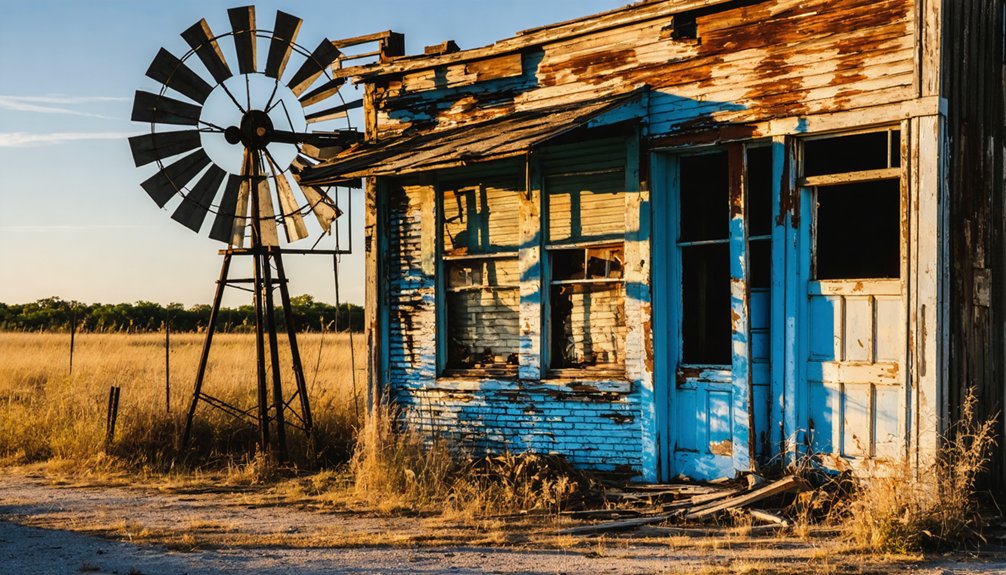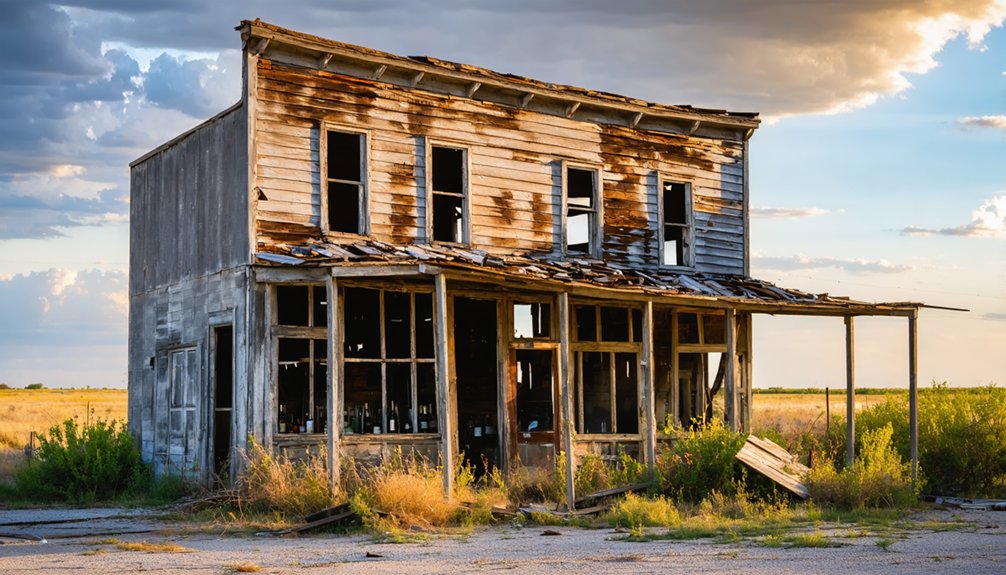You’ll find Browning among Texas’s notable ghost towns, established in 1850 by Isaiah Browning near Bachman’s Branch. The settlement thrived through cotton production, with 25 gins operating by 1900. When railroad companies bypassed the town in the early 1900s, Browning’s isolation led to its decline. Today, you can explore dilapidated structures and vintage infrastructure that tell the story of this once-prosperous pioneer community’s rich frontier heritage.
Key Takeaways
- Founded by Isaiah Browning in 1850, the Texas settlement flourished initially through agriculture, particularly cotton production and trade.
- Railroad companies bypassing Browning led to its isolation and eventual abandonment as neighboring rail-connected communities prospered instead.
- The town’s decline accelerated when primitive roads couldn’t accommodate modern transportation, leaving it disconnected from major trade routes.
- Historical remnants include dilapidated structures and vintage infrastructure, showcasing early 20th-century technology and the town’s original layout.
- The post office closed in 1902, marking a significant milestone in Browning’s transformation from thriving settlement to ghost town.
Origins of a Frontier Settlement
When Isaiah Browning left Oxford, Mississippi in the mid-19th century, he couldn’t have known his frontier settlement would become one of Texas’s many ghost towns. Driven by pioneer motivations common to the era, Browning established his namesake community around 1850, marking his family’s claim on the Texas frontier.
Like many settlers of the time, you’d have found the Brownings facing typical settlement challenges – carving out a life in untamed territory while building the foundations of a new community. The establishment of a large house in 1870s marked the first significant permanent structure in the area. Much like the later town of Thurber, they dealt with the difficulties of isolated frontier life as they worked to build their settlement.
The town reflected the spirit of frontier expansion, with early residents primarily consisting of Southern migrants seeking opportunities in Texas’s promising landscape. As the settlement grew, it became a reflection of the determination of its founding family, whose name would forever be linked to this patch of Texas soil.
Early Pioneer Life and Development
As Isaiah Browning’s frontier settlement took root in 1850, you’d have found the early pioneers establishing the foundations of community life through homesteads, agricultural ventures, and social bonds.
Pioneer resilience was evident in W.W. Browning’s determination to rebuild his plantation house after storm damage, while families like the Millers joined the growing settlement in 1874, forming the Miller-Browning Colony.
You’d have witnessed the community’s organization emerge through the establishment of burial grounds in 1906, maintained by groups like the Pioneer Quilting Club.
The settlement grew near Bachman’s Branch, formerly known as Browning’s Branch, which provided a vital water source for the community.
Settlers faced harsh weather, isolation, and the challenges of frontier life, working together to clear land and build infrastructure.
They adapted to Hill Country conditions, creating a self-sufficient agricultural community where family networks supported essential social functions and development projects. The area experienced significant growth when Bill Smith was appointed as the first postmaster in 1885.
Agricultural Heritage and Trade
If you’d visited Browning in the late 1800s, you’d have seen cotton fields stretching across the landscape and heard the steady hum of the local cotton gin processing the community’s primary crop.
Local farmers brought their corn and other grains to the town’s gristmill, where the produce was ground into meal and flour for both local use and regional trade. The town’s early settler Isaiah established this vibrant agricultural community after arriving from Mississippi in 1850.
The agricultural goods moved along Farm to Market Road 2767 and through the general store, creating essential commerce links between Browning’s roughly 50 residents and neighboring Smith County communities.
Cotton and Corn Production
The agricultural transformation of Brown County began with modest cotton cultivation in 1869, though the 1870 Census recorded no ginned bales. You’ll find that cotton innovations rapidly transformed the landscape after Brooke Smith built the area’s first gin in 1877.
By 1900, you could count 25 cotton gins, with four in Brownwood alone. Local farmers saw production soar to 24,154 bales by 1903, helped by the arrival of railroads and favorable rainfall. The arrival of the Santa Fe Railroad in 1885 dramatically increased migration and settlement in the region. Robert S. Munger’s invention of automated ginning systems in 1884 revolutionized cotton processing across Texas.
While cotton dominated the economy, corn diversification played an essential role in the region’s resilience. You’d have seen corn prioritized during the Civil War when cotton trade was disrupted.
The introduction of barbed wire fencing and improved farming techniques benefited both crops, while crop rotation between cotton and corn helped maintain soil health and manage pests.
Local Market Trading Routes
Trading networks through Browning’s territory traced back to indigenous pathways established by Comanche traders, who masterfully connected Pueblo villages in New Mexico to northern Blanco County.
You’ll find these early routes carried luxury items like marine shells, obsidian, and turquoise across vast distances.
After 1870, you’d see local trade evolve as cattle drives shifted westward from the Chisholm Trail to routes like the Dodge City Trail.
Market routes adapted when Fort Worth emerged as a crucial railhead, though drovers still moved 90% of cattle between 1866-1890.
As settlers arrived post-Red River War, Browning’s landscape transformed with ranches and farms, creating new patterns of commerce.
Local market trading expanded beyond livestock to include diverse agricultural products, while maintaining connections to regional trading centers like Buffalo Gap and Wichita Falls.
The Spanish authorities actively fostered trade relations by providing guns and ammunition to Comanche traders, strengthening economic ties in the region.
Transportation’s Impact on Decline
You’ll find that Browning’s decline accelerated sharply when the railroad companies chose to bypass the settlement in favor of nearby towns with more advantageous terrain.
The situation mirrored Sherwood’s fate when county power shifted to rival town Mertzon after losing rail access.
As many Texas communities experienced a similar rail-dependent fate, the town’s isolation from major transportation routes sealed its eventual abandonment.
The lack of rail connectivity meant local farmers couldn’t efficiently transport their cotton and grain harvests to regional markets, while competing agricultural communities along the rail lines flourished.
The situation worsened as early road networks also developed away from Browning, leaving the once-promising settlement increasingly isolated from essential transportation arteries.
Railroad Bypass Effects
When major railroad companies bypassed Browning in the late 19th and early 20th centuries, they dealt a devastating blow to the town’s future prospects. The railroad economics of the era favored larger settlements, with companies receiving bonuses for specific routes that excluded Browning from the crucial transportation network.
You’ll find that neighboring towns like Atascosa and Jourdanton quickly surpassed Browning as regional hubs, attracting businesses and settlers with their direct rail access. The transportation history of the region shows how rail-connected communities flourished while Browning struggled to ship its agricultural and timber products to market.
Without reliable rail service, you couldn’t maintain competitive shipping costs or attract new investment, leading to a downward spiral of declining population and diminishing economic opportunities.
Early Road Network Changes
Beyond the railroad’s impact, Browning’s early road networks played a significant role in the town’s decline.
You’d have found the town thriving when stagecoaches and wagons transported cotton along its dirt roads, but this prosperity wouldn’t last. As automobiles became common, Browning’s primitive roads couldn’t meet modern transportation needs.
The transformation hit hard when major freight routes shifted away from the town. You would’ve seen the effects cascade – road maintenance dwindled as state funding focused on newer highways that bypassed Browning completely.
The town’s businesses suffered as travelers no longer needed to stop there. Without well-maintained roads connecting to major transportation arteries, Browning’s isolation grew. Local commerce dried up, and residents began moving to better-connected communities, leaving their once-bustling town behind.
Modern-Day Remnants and Legacy

Today, the remnants of Browning stand as silent witnesses to Texas’s pioneering past, with several dilapidated structures still dotting the landscape.
You’ll find architectural remnants like old gas stations and antique shops, though most have succumbed to decades of weathering. The foundations and roofless buildings you’ll encounter reveal the town’s original layout, while surviving infrastructure, including vintage barbed wire fences and historic fire hydrants, showcase early 20th-century technology.
The site’s cultural significance lives on through occasional guided tours and heritage events, drawing photographers and history enthusiasts.
While only a handful of residents remain as caretakers, they help preserve Browning’s identity through maintenance of key structures and participation in local cultural activities, ensuring this piece of Texas history isn’t lost to time.
Research Findings and Historical Records
Historical records reveal rich details about Browning’s founding and development, starting with Isaiah Nicholas Browning and Mary Ann Morrison’s migration from Oxford, Mississippi in 1850.
Documentation traces Browning’s growth through several key sources that highlight the town’s evolution in eastern Smith County.
You’ll find these significant historical findings about Browning’s history:
- The post office records show multiple relocations between Browning and Starrville before its 1902 closure.
- School census data from 1903 documents educational segregation with 51 white students and 47 black students in separate one-teacher schools.
- Property records confirm the town’s first large house, built in the 1870s, survived until at least 1990.
These records paint a picture of a modest but structured community that eventually succumbed to regional economic changes.
Frequently Asked Questions
Were There Any Notable Crimes or Lawless Incidents in Browning’s History?
You’d expect wild tales of outlaws, but there’s no documented crime timeline or notable lawless incidents in Browning’s history. Without formal law enforcement, the town stayed surprisingly peaceful compared to neighboring settlements.
What Indigenous Peoples Originally Inhabited the Area Before Browning’s Settlement?
You’d find Athapascan peoples first inhabited the area around 800 A.D., establishing tribal connections through bison hunting. They were later displaced by the Comanches, who dominated the region’s cultural heritage until settlement.
Did Any Famous Historical Figures Ever Visit or Stay in Browning?
You won’t find records of any famous visitors or notable historical events in this settlement. The town’s remote location and small population kept it off the beaten path of prominent figures.
What Natural Disasters or Epidemics Affected the Town’s Population?
Like searching for shadows in sunlight, you won’t find records of disease outbreaks or flood damage affecting Browning. Historical documents don’t mention any natural disasters impacting the town’s population.
Were There Any Local Legends or Folklore Associated With Browning?
You’ll find ghost sightings reported near old mine shafts, with local myths telling of restless miners’ spirits and strange lights in the woods surrounding Browning’s abandoned structures at night.
References
- https://www.youtube.com/watch?v=Zd8-gKw-5Hc
- https://mix941kmxj.com/see-how-two-texas-ghost-towns-battled-for-the-county-and-lost/
- https://www.southernthing.com/ruins-in-texas-2640914879.html
- https://www.ghosttowns.com/states/tx/browning.html
- https://mix931fm.com/12-east-texas-ghost-towns/
- https://en.wikipedia.org/wiki/List_of_ghost_towns_in_Texas
- https://discovertexasoutdoors.com/places/browning/
- https://www.tshaonline.org/handbook/entries/browning-tx
- https://www.youtube.com/watch?v=phjUE19A8HM
- https://jamesbigleyranches.com/general/texas-ghost-towns/



